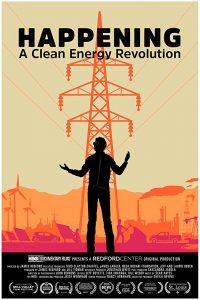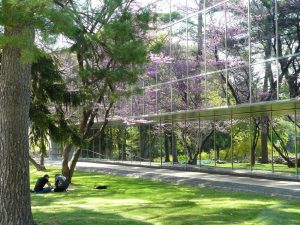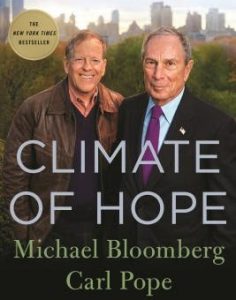January, 2018
now browsing by month
Community Green Organizing
 By Jan Barry
By Jan Barry
One town’s action plan addressing climate change and other environmental issues began nearly a decade ago in a community event at the high school on a wintry Saturday morning. The “Bedford Environmental Summit” was called by the town’s garden club and its energy advisory panel. One thousand people showed up.
The latest step in moving the town environmental action plan along is the Bedford 2020 Climate Action Summit scheduled for Saturday, Feb. 3, 2018 at Fox Lane High School in Bedford, NY. Even for people who can’t attend this event, the innovative eco-group has provided lots of useful information on its Facebook page and website.
The civic group’s mission “is to lead, organize and promote a community wide effort to reduce greenhouse gas emissions 20% by 2020 and to create a sustainable community that conserves its natural resources,” the local environmental organization states on its website, which features a cornucopia of community activities information and organizing tips.
The Bedford 2020 Coalition has plugged into and in some cases energized a network of likeminded organizations in Westchester County and elsewhere in the Hudson Valley region. Notable residents of the New York City exurban commuter town have included Donald Trump and a movie marque-ful of famous actors and actresses. Organizers of the environmental action group, however, are “over 90 community volunteers, many of whom are professionals and experts with deep experience and credentials in our action areas.”
One of the most useful items on the Bedford 2020 website is a “Summit in a Box,” which provides an online manual for creating a community environmental action plan.
“Global warming and environmental issues are the central challenge of our times. The goal of the Bedford Environmental Summit (BES) was to find a way to educate our community about the most pressing environmental issues of the day, to create a ‘community of advocates’ who would take actions to solve these problems on a local level,” the executive summary for the manual states. “We believe that the BES is a worthy model for any community or organization whose goal is to encourage grass roots, local actions to mitigate the challenges presented by greenhouse gas emissions and diminishing natural resources.”
The first step in Bedford was holding the community event at the high school in January 2009, which drew 1000 people in a town of 17,000 residents. More than 240 volunteers, including 88 students, organized the event, which offered 85 speakers presenting key information on 28 topics. In the hallways, 78 Expo tables with information on environmental issues and organizations were set up and a locavore breakfast and lunch were provided, the organizing manual noted.
The community summit led to creation of the nonprofit Bedford 2020 Coalition, “whose mandate is to implement over 70 projects recommended in BEAP’s Climate Action Plan to reduce greenhouse gas emissions 20% by 2020; the creation of a ‘sustainable school district’ and many individual and collaborative projects emanating from the networking that occurred at the Summit,” the manual summary continued.
“The key elements to the success of the BES were an effective public/private partnership in co-sponsoring the event; a comprehensive and appealing program of lectures, workshops and Expo exhibits that provided multiple points of entry for individuals in the community to get engaged; extensive community involvement in the form of local organizations who were enlisted as ‘partners’ to assist in the planning and implementation of the Summit; and the focus by Summit organizers on ‘what happens next’ to motivate participants to think beyond the day of the Summit.”
What happened next were volunteer-organized programs to involve residents in energy conservation and installing solar panels on homes and businesses, composting food waste, reducing use of chemical fertilizers and pesticides on lawns, boosting recycling of plastic, metal, glass and paper products, switching to a hybrid or electric car, and participating in Meatless Mondays to help reduce the amount of fossil fuel that goes into feeding and transporting beef cattle for hamburgers, chili con carne and steaks. Restaurants throughout town signed on as partners.
Local actions over the next several years helped create a county-wide network that by 2017 enlisted Westchester County and 20 town governments in Sustainable Westchester, “a consortium of local governments that facilitates green initiatives like Solarize Westchester, Community Choice Aggregation and the Municipal Solar Buyers Group.” A New York state program enables municipalities to choose getting 100 per cent of their electricity from solar, wind and hydro and “save money by negotiating bulk pricing for their supply.” The Town of Bedford is one of the municipalities participating in the state program.
“Bedford 2020 harnesses the power of community and drives action. This year, we have inspired thousands of people to reduce waste, increase efficiency, take on big green solutions and address climate change,” the group’s leaders stated in an October 2017 progress report. “Together we are reducing greenhouse gas emissions and protecting natural resources in Bedford and beyond.”
In an addendum to the progress report, the elected town supervisor, Chris Burdick, states: “We are proud that our Town has pledged a commitment to the Paris Climate Accord goals, with Bedford 2020 leading the way.”
For more information:
http://bedford2020.org/climatesummit2018/
Happening: A Renewable Energy Action Film
 By Jan Barry
By Jan Barry
Stepping from behind the camera, documentary filmmaker James Redford invites viewers to join him on a cross-country trip to explore notable milestones in the renewable energy transformation of America.
Redford, the son of actor and environmental activist Robert Redford and an accomplished documentary director on a variety of topical issues, debuted as an on-camera host before a national audience whenHappening: A Clean Energy Revolution opened recently on HBO. That attracted the serious attention of cable TV program reviewers.
“Cities like Buffalo, NY, a former manufacturing hub, are being revitalized by the clean energy revolution,” Broadway World reported in the no-nonsense style of business news reports. “There, Redford visits the site of the largest solar panel manufacturing plant in the western world, which will employ more people than the former steel plants that once sustained the community. …
“Even big business recognizes the benefits,” the Broadway World report continued. “All of Apple’s U.S. facilities are now 100% renewable-powered. During a visit to an Apple data center [in Oregon], Redford learns that the company built its own solar farm in order to control its energy source.”
Summarizing another newsworthy story that Redford films in Texas, Broadway World informs its readers that “Dale Ross, the conservative mayor of Georgetown, Tex., also maintains that clean energy is cost-effective, and goes beyond partisan politics. Offered a lucrative long-term deal by wind and solar companies, Georgetown became the second U.S. city to run on 100% renewable energy. Soon, solar energy will be as affordable as, or more affordable than, fossil fuels in 47 states, according to Emily Kirsch, a CEO who funds solar startups. Kirsch stresses that the clean energy industry can ‘democratize energy production and consumption,’ and already employs more people than Google, Apple, Facebook and Twitter combined.”
A reviewer on the Bill Moyers program, documentary filmmaker Titi Yu, was impressed. In an interview with Redford, she said “it was very effective to have you in the film” talking with clean energy innovators across the nation, including civic activists in Nevada who convinced the state legislature and Republican governor to enact clean energy bills into law.
Redford replied: “I just decided to open up my own process of discovery. I decided to take everyone along on the ride. I think there is an inherent resistance to the topic of clean energy and renewable energy. It sounds kind of boring. I thought, well, maybe this might make it a little interesting. Also, I didn’t major in science or technology so I thought if I can understand this, so can everyone else.”
“You started the journey in your own home,” Yu continued, citing a scene in Redford’s house in northern California, where he decides to install solar panels on the roof. “You tracked your own power line to an ugly power plant that was across the bay from a wind farm. I thought it really brought it home how we all have a stake in this green energy revolution and there are many things we can all do, starting with ourselves.”
Redford expands on that point in his directors’ statement on the documentary website. “During the journey of making ‘happening’, I met many inspiring citizens, business leaders and politicians leading the clean energy revolution, but the most significant journey involved my own heart and mind,” he wrote. “At the start of ‘Happening’, I was feeling pretty cynical about the value of political engagement. Three years later, I have witnessed first-hand the enduring value of politically engaged citizenry.
“In spite of the turbulent political divides we are currently enduring,” he continued, “I feel more hopeful today than ever about our ability as Americans to combat climate change, and I am excited to share this with audiences so that they may feel this way as well.”
For more information:
billmoyers.com/story/much-needed-hope-planet-earth-happening-clean-energy-revolution/
Saving the Earth Is Up to Us

By Jan Barry
The new administration in Washington is determined to roll back environmental protection regulations and dismisses global climate change as a hoax. As a nation poisoned by industrial pollution, we’ve been there before. But more people today have the means to learn what they can do about it.
There are good models of effective civic actions all over this country.
A group of residents in a rural corner of New Jersey organized a campaign that saved a large wetland area called the Great Swamp from being paved over for a proposed airport, before there was an environmental protection agency. A larger group of residents in towns along the New York-New Jersey border waged a campaign that saved Sterling Forest, a headwaters area for drinking water for millions of people, from being paved over to create a new city. An even larger coalition of civic groups waged a campaign that transformed the Hudson River from an industrial and municipal sewer into a much cleaner estuary.
Those are examples I highlighted in A Citizen’s Guide to Grassroots Campaigns, a book published in 2000 based on my newspaper reporting on effective civic actions. Federal environmental protection laws such as the clean water act were enacted because of a nationwide campaign that turned out 20 million people on the first Earth Day in 1970. And that was done the old-fashioned way, before the Internet or cell phones. What is needed now is a sustained campaign to focus what people can do working together to be as meaningful as that first Earth Day event.
Recently, a statewide coalition convinced New York Governor Andrew Cuomo to ban hydraulic fracking for oil and gas to protect New York City’s water supply streams and reservoirs in the Catskills and water supply aquifers across the state. In Philadelphia, PA a citywide coalition named Green Justice Philly convinced Pennsylvania Governor Tom Wolf to back a plan for a greener expansion of port facilities, rather than a gas fracking company’s proposed project.
On the West Coast, San Diego, California, is implementing a plan to dramatically reduce greenhouse gasses by shifting to renewable energy. This is a result of the work of a diverse coalition of elected officials, business leaders, labor unions, environmental, social justice and community organizations. San Diego’s Climate Action Campaign reports on its website that it is now “engaged with thirteen other municipalities in San Diego and Orange Counties to develop and pass similarly transformative plans.”
At a Sierra Club rally outside Environmental Protection Agency labs in Edison, NJ last winter, commercial tractor trailer truck drivers repeatedly honked in support of signs such as “Global Warming Is Real It’s 70 Degrees in February” and “EPA is for Environmental Protection, not Corporate.” Standing among the signs brandished by a vocal crowd of citizen activists was US Representative Frank Pallone and state and local elected officials. “We need to protect Americans’ fundamental right to clean air, clean water and a safe environment to raise their families,” Pallone said. “I am proud to stand with the Sierra Club and committed citizens against President Trump’s dangerous environmental policies.” It was a scene that has flared up and fired up people for years in New Jersey, where civic campaigns have forced cleanups of toxic sites and saved large swathes of the state from destructive development.
For more information:
| A Citizen’s Guide to Grassroots Campaigns: Jan Barry www.amazon.com A Citizen’s Guide to Grassroots Campaigns and over one million other books are available for Amazon Kindle. |
||
| New York and fracking – SourceWatch www.sourcewatch.org In New York, fracking wastewater from Marcellus Shale operations, such as in Pennsylvania, has been sent to at least five upstate New York landfills, even … |
||
| Philly Activists Take on Fossil Fuel Giants — and Win www.foodandwaterwatch.org The fracking industry spent big money to expand a dirty refinery in South Philly. But local activists and climate campaigners fought back, because communities harmed by fossil fuel pollution needed jobs, not more dirty air. |
||
| www.climateactioncampaign.org/ | ||
Give the Gift of a Better Future

By Jan Barry
The threat of severe world-wide climate change is not theoretical, but horrifically real, thousands of scientists warned in a recent letter to humanity. Averting global disaster, they assert, will take an historic culture change.
“[A] great change in our stewardship of the Earth and the life on it is required, if vast human misery is to be avoided,” the open letter published November 13 in Bioscience maintained, reiterating a stark warning from scientists issued twenty-five years ago. “Since 1992, with the exception of stabilizing the stratospheric ozone layer, humanity has failed to make sufficient progress in generally solving these foreseen environmental challenges, and alarmingly, most of them are getting far worse,” the updated evaluation signed by more than 15,000 scientists concluded.
“With a groundswell of organized grassroots efforts, dogged opposition can be overcome and political leaders compelled to do the right thing,” the scientists’ call to action stated. “It is also time to re-examine and change our individual behaviors, including limiting our own reproduction (ideally to replacement level at most) and drastically diminishing our per capita consumption of fossil fuels, meat, and other resources.”
Civic campaigns can change the course of human events. Grassroots movements in the past century gained women the right to vote, extended civil rights to disenfranchised descendants of slavery, halted atmospheric tests of nuclear explosions, and convinced the governments of the US and USSR to negotiate an end to the Nuclear Age and its suicidal strategy of “Mutual Assured Destruction.”
A good start would be to create an action plan to guide us at home, at work, in schools, in religious and social groups and in government. Here are some suggestions, which hopefully spark additional practical ideas.
Climate Change Action List
Reduce eating beef.
About 18% of greenhouse-gas emissions worldwide comes from cattle, sheep and goat manure, meat production and shipping, according to the U.N. Food and Agriculture Organization. Meatless Mondays, fish on Fridays, more veggies, chicken, turkey.
Reduce vehicle impacts.
Nearly 20 percent of US emissions comes from cars and trucks, the Union of Concerned Scientists reports. Walk more, drive less, drive more efficiently, take a bus, take a train, carpool, ride a bike, get electric or hybrid car.
Reduce electricity impacts.
Nearly 30 percent of US emissions comes from electricity generation, the USEPA notes. Turn off lights that are not needed, turn off computers when not in use, choose energy efficient replacements of light bulbs, washers, dryers, refrigerators, air conditioning units, boost use of solar and wind power.
Reduce use of plastic bags, bottles and wrapping.
About 6 percent of world oil production is used to make plastic items, according to the World Economic Forum, with a projected increase of more than three times if current trends continue. Switch from plastic shopping bags to reusable bags, reduce use of plastic wrapping, reduce use of, recycle and replace plastic water bottles.
Recycle reusable materials.
Recycling and composting programs in Washington, Oregon and California reduce emissions equivalent to taking more than 6 million vehicles off the roads, a study by the West Coast Climate and Materials Management Forum found. Key areas are: carpets, cans, bottles, paper, lumber and food scraps.
Increase tree cover.
About 12 percent of US emissions in 2015 were offset by carbon accumulation in woodlands, the USEPA reports. Plant trees, stop clear cutting of forests, reduce forest fires.
Increase family planning.
Our “global population – projected to rise from around 6.8 billion people today to 9.2 billion by 20504 – will inevitably lead to a significant increase of greenhouse gas emissions,” the World Health Organization reports. This touchy topic needs to be sensibly addressed, the newly formed Alliance of World Scientists argues.
Help prevent nuclear war.
Nuclear winter “would produce climate change unprecedented in recorded human history,” Dr. Alan Robock of Rutgers University wrote in the journal Nature. Sunlight dimmed by long-lasting layers of smoke from a limited exchange of nuclear explosions, he stated, would drop temperatures below the “‘Little Ice Age’ (1400-1850), during which famine killed millions.” Speaking at a symposium on The Dynamics of Possible Nuclear Extinction at the New York Academy of Medicine in 2015, Dr. Robock said the best solution to such a threat is to greatly reduce the number of nuclear weapons, while working to eliminate them altogether.
Bloomberg and Green Activist Team Up on Climate Change
By Jan Barr y
y
Climate of Hope: How Cities, Businesses, and Citizens Can Save the Planet burst into the public arena just before Earth Day 2017. A joint communique by former New York Mayor Michael Bloomberg and former Sierra Club Executive Director Carl Pope, the heavily promoted book presents a formidable counterweight to the Trump administration’s assault on climate change action and environmental protection regulations.
In a remarkable networking move, the billionaire businessman and the backpacker environmental activist present a comprehensive plan for a grassroots campaign on climate change that builds on actions already begun in cities and states across the US and around the world. Writing in alternating chapters, they make a case for local civic actions to set the pace on addressing threats to the environment.
“No matter what happens in Washington, no matter what regulations the Trump administration adopts or rescinds, no matter what laws Congress may pass, market forces, local (and in some cases state) governments, and consumer demand for cleaner air will, together, allow the United States to meet and exceed the pledges that the Obama administration made in Paris,” Bloomberg contends.
“The reason is simple: cities, businesses, and citizens will continue reducing emission, because they have concluded … that doing so is in their own self-interest.”
It’s an approach that surely appeals to Sierra Club campaigners. “As the director of the Sierra Club’s Ready for 100 campaign,” Jodie Van Horn wrote in a review on the Sierra Club website, “I am heartened that Bloomberg and Pope see the battle against global warming as one that can be effectively waged at the municipal level, irrespective of the current regressive political climate in Washington, D.C., and lack of leadership emanating from Inside the Beltway.
“Ready for 100 is asking mayors, pastors, principals, civic and community leaders, parents, and students in cities large and small to commit to solutions that will help us achieve 100% clean energy across the United States by 2050,” she continued, noting that 26 cities have already committed to the 100 percent goal, including San Diego, San Francisco, and Salt Lake City.
It’s an approach that also appeals beyond liberal enclaves such as New York and the West Coast. Matthew D’Ancona, a conservative political columnist in London, likes the networking of local government leaders on environmental issues described in this book.
“Bloomberg has been UN special envoy for cities and climate change since 2014, and is the driving force behind the Global Covenant of Mayors for Climate and Energy, a coalition of 7,000 cities in 112 countries,” D’Ancona noted in a book review in the London Evening Standard. “Because mayors are engaged in such a specific and detailed way with the needs of their cities — and are daily accountable to their voters — they are perfectly placed between individual citizens who often feel powerless and national governments that move at a snail’s pace in their quest for global collaboration.”
“Accordingly,” the British journalist continued, “there is much here for our own city authorities — and every newly-elected metro mayor — to learn from. It is a model text for those who argue that decentralisation works best and that most of the challenges facing humanity in the 21st century require localised solutions.”
In response to a question on WNYC Radio’s “Morning Edition” about the bitter political divide in the US on climate change, Pope pointed out that pragmatism is often more powerful than politics at the community level.
“It’s a very partisan issue at the national level,” Pope said. “But if you get down to the local level and you look at which cities are choosing to embrace clean energy, it turns out the first big American city to say it was going to be a hundred percent renewable was San Diego, which has a Republican mayor. Another big city that has said it’s going to go 100 percent renewable is Salt Lake City, the largest city in the reddest state in the country.”
For more information:
http://www.sierraclub.org/planet/2017/04/climate-hope
http://www.npr.org/2017/04/26/525675189/michael-bloomberg-and-carl-pope-on-climate-of-hope
Sustainability or Lights Out
 By Jan Barry
By Jan Barry
Modern people act quite often as though the Earth were replaceable—trash this one, order a new one in the morning. So it may have been a revelation for many who heard Pope Francis tell world leaders at a United Nations General Assembly meeting in New York that harm to the environment harms us too.
Speaking out against “misuse and destruction of the environment” and a growing “culture of waste,” which has left increasing numbers of people impoverished and living in places poisoned by toxic spills and contaminated air and water, the leader of the Roman Catholic Church said the universe was not created by God for humans to tear apart. Man was given a gift of living on this Earth, Francis added, “he is not authorized to abuse it, much less to destroy it.”
In his UN address in September 2015, on the heels of an historic speech to Congress, and in a widely disseminated environmental encyclical to the people of the world, the head of one of the world’s major religions mounted a campaign to get government leaders and ordinary folks to seriously tackle environmental protection through social and economic transformations.
At a forum at Ramapo College on Pope Francis’ call for action on environmental protection, a man stood up in the audience and said: “We have to start acting now! My children and grandchildren may not have a place to live.” Addressing the panel of environmentally minded professors, the speaker continued: “I was a student here in 1975-80. We were encouraged to be activists. We were provided tools to be activists.”
A few weeks later, Rampo College hosted a conference on student activism on environmental sustainability. President Peter Mercer said this focus is a priority for the state college, which borders the Ramapo River, a regional water supply stream, in Mahwah, NJ. Billed as “Campus Sustainability Day,” the event provided an opportunity for student leaders in various clubs to hear report outs from department heads about environmentally focused changes on campus—such as installing LED lights and cutting uses of paper—and to offer ideas for additional actions.
Among the students’ suggestions: institute a required course in sustainability in every major, turn lawns into “sustainable landscaping” such as wildflower meadows, provide compostable plates, cups and utensils in dining halls and at conferences. “We’re working on a project to have 100 percent of food waste go to compost,” announced a student activist.
A few days later, the college hosted a conference for community activists on climate change and energy issues. Sponsored by the public interest group Food & Water Watch, the conference attracted more than 100 environmental activists from the New York metropolitan region. Many were there to exchange ideas on how to counter a deluge of fracked oil and gas being shipped by trains, barges and pipelines to refineries in New Jersey. Rail lines and pipelines cut through water supply areas and residential neighborhoods, state parks and forests.
Panelists included leaders of the Coalition to Ban Unsafe Oil Trains, Coalition Against Pilgrim Pipeline, NJ Working Families, NJ Pinelands Preservation Alliance, New Jersey Environmental Justice Alliance, Sane Energy Project and many other groups. “You can feel change coming,” said Lawrence Hamm, a Newark-based civil rights activist, addressing the crowd in the keynote address. “We must reestablish our connection with Nature…We need to join these movements together in the same fight.”
For more information:


